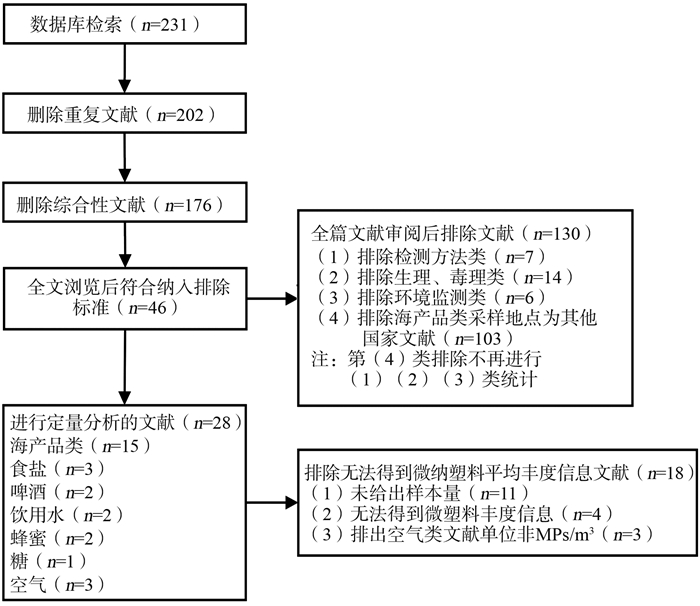Analysis of the characteristics of micro- and nanoplastics exposure to Chinese population via ingestion and inhalation
-
摘要:
目的 分析中国居民经食物摄入和空气吸入微纳塑料(micro- and nanoplastics, MNPs)暴露特征。 方法 使用关键词检索PubMed、Web of Science、Scopus、中国知网和万方数据知识服务平台等国内外数据库,建立数据集,结合中国人群食物消费量和人体呼吸参数,计算中国居民经食物摄入和空气吸入的MNPs暴露量,与国外数据比较分析其MNPs暴露特征。 结果 分析来自28篇研究的4 511个样本数据显示,中国居民每年摄入约187 000~328 000个MNPs,考虑空气吸入,每年MNPs暴露量为192 000~335 000个MNPs,均高于美国居民暴露量。男性成年人MNPs摄入量最高。生活饮用水、海产品、瓶装水和空气是中国居民每日主要MNPs暴露源。中国居民经食物摄入MNPs类型以聚乙烯、聚丙烯和聚对苯二甲酸乙二酯为主,而经空气吸入MNPs类型以聚对苯二甲酸乙二酯、尼龙和聚丙烯腈为主。 结论 相比于美国居民,中国居民具有更高的MNPs暴露风险,削减饮用水和海产品中MNPs含量,可有效降低中国居民MNPs暴露风险。 Abstract:Objective To analyze the characteristics of Chinese population exposure to micro- and nanoplastics (MNPs) via food ingestion and air inhalation. Methods Articles published up to April 2020 were searched in PubMed, Web of science, Scopus, China National Knowledge Infrastructure, Wanfang and Weipu databases. Then, the exposure levels of MNPs by food ingestion and air inhalation pathways were caculated by referring to the Chinese population food consumption and breathing rates data. The exposure characteristics of MNPs were evaluated between Chinese and foreign population. Results A total of 4 511 samples data from 28 studies were retrieved. Annual consumption of MNPs among Chinese population were estimated to range from 187 000 to 328 000 particles for food ingestion depending on age and sex and increase to 192 000 and 335 000particles when air inhalation is also considered, which were larger than those of American persons. Ingestion MNPs posed largest health risk to male Chinese adults. Drinking water, seafood, bottled water as well as air represented four substantial vectors of daily MNPs expsoure. The main types of MNPs were polyethylene, polypropylene and polyethylene terephthalate for ingestion expsosure while polyethylene terephthalate, polyamide and Polyacrylonitrile for inhalation exposure. Conclusions Ingestion and inhalation of MNPs posed higher health risk to Chinese population in comparison to that of American population. The attempt to lower the MNPs levels in drinking water and seafood would represent the most effective means to help reduce the MNPs exposure risk to Chinese residents. -
Key words:
- Microplastics /
- Nanoplastics /
- Ingestion /
- Inhalation /
- Chinese population
-
表 1 食物和环境介质中微纳塑料检测数据质量评分细则
Table 1. Rules for scoring the quality of MNPs testing data in food and environmental media
评价指标 高(2分) 中(1分) 低(0分) 采样方法 详细描述或给出依据的规范或标准 简单描述 未给出 样本含量 每种类别>30 总共>30 未给出或<30 样本运输 4 ℃低温运输 常温运输 现场处理样品 实验室准备 穿棉质实验服、严格洗涤和漂洗实验设备 仅擦拭设备表面、阴性对照检查污染 未采取防护措施 实验室处理 有前处理及具体方法 有前处理但无具体方法 无前处理步骤 清洁空气条件 清洁空气条件 未指出,但有阴性对照检查污染 未给出 阴性对照 每批样品≥3份重复空白 简单的空白对照 无阴性对照 阳性对照 ≥3份测定微纳塑料加标回收率 仅对方案设计中一部分进行阳性对照 无阳性对照 样本检测 全部采集样品 非全部采集样品 不清楚 聚合物鉴定 热分析法或光谱分析法 视觉识别 -
[1] Plastics Europe. Plastics, the facts 2019 [EB/OL]. (2019-10-14) [2020-06-12]. http://www.plasticseurope.org. [2] Thompson RC, Olsen Y, Mitchell RP, et al. Lost at sea: where is all the plastic? [J]. Science, 2004, 304(5672): 838. DOI: 10.1126/science.1094559. [3] Arthur C, Baker J, Bamford H, et al. Summary of the international research workshop on the occurance, effects, and fate of microplastic marine debris [C]//Arthur C, Baker J, Bamford H. Proceedings of the international research workshop on the occurrence, effects, and fate of microplastic marine debris. Silver Spring, National Oceanic and Atmospheric Administration, 2009, 10. [4] da Costa JP, Santos PSM, Duarte AC, et al. (Nano)plastics in the environment - Sources, fates and effects [J]. Sci Total Environ, 2016, 566-567: 15-26. DOI: 10.1016/j.scitotenv.2016.05.041. [5] Weithmann N, Möller JN, Löder MGJ, et al. Organic fertilizer as a vehicle for the entry of microplastic into the environment [J]. Sci Adv, 2018, 4(4): eaap8060. DOI: 10.1126/sciadv.aap8060. [6] Peng L, Fu D, Qi H, et al. micro- and nano-plastics in marine environment: Source, distribution and threats-a review [J]. Sci Total Environ, 2020, 698: 134254. DOI: 10.1016/j.scitotenv.2019.134254. [7] Cedervall T, Hansson LA, Lard M, et al. Food chain transport of nanoparticles affects behaviour and fat metabolism in fish [J]. PLoS One, 2012, 7(2): e32254. DOI: 10.1371/journal.pone.0032254. [8] Huerta Lwanga E, Mendoza Vega J, Ku Quej V, et al. Field evidence for transfer of plastic debris along a terrestrial food chain [J]. Sci Rep, 2017, 7(1): 14071. DOI: 10.1038/s41598-017-14588-2. [9] Liebezeit G, Liebezeit E. Origin of synthetic particles in honeys [J]. Pol J Food Nutr Sci, 2015, 65(2): 143-147. DOI: 10.1515/pjfns-2015-0025. [10] Lehner R, Weder C, Petri-Fink A, et al. Emergence of nanoplastic in the environment and possible impact on human health [J]. Environ Sci Technol, 2019, 53(4): 1748-1765. DOI: 10.1021/acs.est.8b05512. [11] Prata JC. Airborne microplastics: Consequences to human health? [J]. Environ Pollut, 2018, 234: 115-126. DOI: 10.1016/j.envpol.2017.11.043. [12] Wang F, Wong CS, Chen D, et al. Interaction of toxic chemicals with microplastics: a critical review [J]. Water Res, 2018, 139: 208-219. DOI: 10.1016/j.watres.2018.04.003. [13] Cox KD, Covernton GA, Davies HL, et al. Human consumption of microplastics [J]. Environ Sci Technol, 2019, 53(12): 7068-7074. DOI: 10.1021/acs.est.9b01517. [14] Schwabl P, Köppel S, Königshofer P, et al. Detection of various microplastics in human stool: a prospective case series [J]. Ann Intern Med, 2019, 171(7): 453-457. DOI: 10.7326/M19-0618. [15] Jambeck JR, Geyer R, Wilcox C, et al. Marine pollution. Plastic waste inputs from land into the ocean [J]. Science, 2015, 347(6223): 768-771. DOI: 10.1126/science.1260352. [16] Geneva: World Health Organization. Microplastics in drinking-water [EB/OL]. (2019-08-28) [2020-05-27]. https://creativecommons.org/licenses/by-nc-sa/3.0/igo. [17] Hermsen E, Mintenig SM, Besseling E, et al. Quality criteria for the analysis of microplastic in biota samples: a critical review [J]. Environ Sci Technol, 2018, 52(18): 10230-10240. DOI: 10.1021/acs.est.8b01611. [18] 吴永宁, 赵云峰, 李敬光. 第五次中国总膳食研究[M]. 北京: 科学出版社, 2018: 68.Wu YN, Zhao YF, Li JG. The 5th China's total diet study [M]. Beijing: Science Press, 2018: 68. [19] 中国营养学会. 中国居民膳食指南: 2016科普版[M]. 北京: 人民卫生出版社, 2016.Chinese Nutrition Society. Dietary Guidelines for Chinese Residents (2016 Edition) [M]. Beijing: People's Medical Publishing House, 2016. [20] 国家卫生计生委疾病预防控制局. 中国居民营养与慢性病状况报告[M]. 北京: 人民卫生出版社, 2015.Disease Prevention and Control Bureau of National Health and Family Planning Commission. Report on Nutrition and Chronic Disease Status of Chinese Residents [M]. Beijing: People's Medical Publishing House, 2015. [21] 环境保护部. 中国人群暴露参数手册(儿童卷6-17岁), [M]. 北京: 中国环境出版社, 2016.Ministry of Environmental Protection of China. Chinese population exposure parameters manual (children's volume 6-17 years old) [M]. Beijing: China Environment Press, 2016. [22] 赵秀阁, 段小丽. 中国人群暴露参数手册(成人卷)概要[M]. 北京: 中国环境出版社, 2014.Zhao XG, Duan Xl. Summary of Chinese population exposure parameters manual (adult volume) [M]. Beijing: China Environment Press, 2014. [23] Sun XX, Li QJ, Shi YQ, et al. Characteristics and retention of microplastics in the digestive tracts of fish from the Yellow Sea [J]. Environ Pollut, 2019, 249: 878-885. DOI: 10.1016/j.envpol.2019.01.110. [24] Wu FZ, Wang YJ, Leung JYS, et al. Accumulation of microplastics in typical commercial aquatic species: a case study at a productive aquaculture site in China [J]. Sci Total Environ, 2020, 708: 135432. DOI: 10.1016/j.scitotenv.2019.135432. [25] Lv W, Zhou W, Lu S, et al. Microplastic pollution in rice-fish co-culture system: a report of three farmland stations in Shanghai, China [J]. Sci Total Environ, 2019, 652: 1209-1218. DOI: 10.1016/j.scitotenv.2018.10.321. [26] Feng ZH, Zhang T, Li Y, et al. The accumulation of microplastics in fish from an important fish farm and mariculture area, Haizhou Bay, China [J]. Sci Total Environ, 2019, 696: 133948. DOI: 10.1016/j.scitotenv.2019.133948. [27] Fang C, Zheng RH, Chen HZ, et al. Comparison of microplastic contamination in fish and bivalves from two major cities in Fujian Province, China and the implications for human health [J]. Aquaculture, 2019, 512: 734322. DOI: 10.1016/j.aquaculture.2019.734322. [28] Huang JS, Koongolla JB, Li HX, et al. Microplastic accumulation in fish from Zhanjiang mangrove wetland, South China [J]. Sci Total Environ, 2020, 708: 134839. DOI: 10.1016/j.scitotenv.2019.134839. [29] Li JN, Qu XY, Su L, et al. Microplastics in mussels along the coastal waters of China [J]. Environ Pollut, 2016, 214: 177-184. DOI: 10.1016/j.envpol.2016.04.012. [30] Koongolla JB, Lin L, Pan YF, et al. Occurrence of microplastics in gastrointestinal tracts and gills of fish from Beibu Gulf, South China Sea [J]. Environ Pollut, 2020, 258: 113734. DOI: 10.1016/j.envpol.2019.113734. [31] Zhu J, Zhang Q, Li Y, et al. Microplastic pollution in the Maowei Sea, a typical mariculture bay of China [J]. Sci Total Environ, 2019, 658: 62-68. DOI: 10.1016/j.scitotenv.2018.12.192. [32] Li JN, Yang DQ, Li L, et al. Microplastics in commercial bivalves from China [J]. Environ Pollut, 2015, 207: 190-195. DOI: 10.1016/j.envpol.2015.09.018. [33] Qu XY, Su L, Li HX, et al. Assessing the relationship between the abundance and properties of microplastics in water and in mussels [J]. Sci Total Environ, 2018, 621: 679-686. DOI: 10.1016/j.scitotenv.2017.11.284. [34] Zhang F, Wang XH, Xu JY, et al. Food-web transfer of microplastics between wild caught fish and crustaceans in East China Sea [J]. Mar Pollut Bull, 2019, 146: 173-182. DOI: 10.1016/j.marpolbul.2019.05.061. [35] Su L, Deng H, Li BW, et al. The occurrence of microplastic in specific organs in commercially caught fishes from Coast and estuary area of East China [J]. J Hazard Mater, 2019, 365: 716-724. DOI: 10.1016/j.jhazmat.2018.11.024. [36] Su L, Cai HW, Kolandhasamy P, et al. Using the Asian clam as an indicator of microplastic pollution in freshwater ecosystems [J]. Environ Pollut, 2018, 234: 347-355. DOI: 10.1016/j.envpol.2017.11.075. [37] Jabeen K, Su L, Li JN, et al. Microplastics and mesoplastics in fish from coastal and fresh waters of China [J]. Environ Pollut, 2017, 221: 141-149. DOI: 10.1016/j.envpol.2016.11.055. [38] Yang DQ, Shi HH, Li L, et al. Microplastic pollution in table salts from China [J]. Environ Sci Technol, 2015, 49(22): 13622-13627. DOI: 10.1021/acs.est.5b03163. [39] Lee H, Kunz A, Shim WJ, et al. Microplastic contamination of table salts from Taiwan, including a global review [J]. Sci Rep, 2019, 9(1): 10145. DOI: 10.1038/s41598-019-46417-z. [40] Kim JS, Lee HJ, Kim SK, et al. Global pattern of microplastics (MPs) in commercial food-grade salts: sea salt as an indicator of seawater MP pollution [J]. Environ Sci Technol, 2018, 52(21): 12819-12828. DOI: 10.1021/acs.est.8b04180. [41] Tong HY, Jiang QY, Hu XS, et al. Occurrence and identification of microplastics in tap water from China [J]. Chemosphere, 2020, 252: 126493. DOI: 10.1016/j.chemosphere.2020.126493. [42] Mason SA, Welch VG, Neratko J. Synthetic polymer contamination in bottled water [J]. Front Chem, 2018, 6: 407. DOI: 10.3389/fchem.2018.00407. [43] Liebezeit G, Liebezeit E. Synthetic particles as contaminants in German beers [J]. Food Addit Contam Part A Chem Anal Control Expo Risk Assess, 2014, 31(9): 1574-1578. DOI: 10.1080/19440049.2014.945099. [44] Kosuth M, Mason SA, Wattenberg EV. Anthropogenic contamination of tap water, beer, and sea salt [J]. PLoS One, 2018, 13(4): e0194970. DOI: 10.1371/journal.pone.0194970. [45] Wiesheu AC, Anger PM, Baumann T, et al. Raman microspectroscopic analysis of fibers in beverages [J]. Anal Methods, 2016, 8(28): 5722-5725. DOI: 10.1039/c6ay01184e. [46] Liebezeit G, Liebezeit E. Non-pollen particulates in honey and sugar [J]. Food Addit Contam Part A Chem Anal Control Expo Risk Assess, 2013, 30(12): 2136-2140. DOI: 10.1080/19440049.2013.843025. [47] Liebezeit G, Liebezeit E. Origin of synthetic particles in honeys [J]. Pol J Food Nutr Sci, 2015, 65(2): 143-147. DOI: 10.1515/pjfns-2015-0025. [48] Liu K, Wang XH, Fang T, et al. Source and potential risk assessment of suspended atmospheric microplastics in Shanghai [J]. Sci Total Environ, 2019, 675: 462-471. DOI: 10.1016/j.scitotenv.2019.04.110. [49] Liu K, Wang XH, Wei N, et al. Accurate quantification and transport estimation of suspended atmospheric microplastics in megacities: Implications for human health [J]. Environ Int, 2019, 132: 105127. DOI: 10.1016/j.envint.2019.105127. [50] Li YW, Shao LY, Wang WH, et al. Airborne fiber particles: Types, size and concentration observed in Beijing [J]. Sci Total Environ, 2020, 705: 135967. DOI: 10.1016/j.scitotenv.2019.135967. [51] McCarthy J, Gong X, Nahirney D, et al. Polystyrene nanoparticles activate ion transport in human airway epithelial cells [J]. Int J Nanomedicine, 2011, 6: 1343-1356. DOI: 10.2147/ijn.s21145. [52] Cai LQ, Wang JD, Peng JP, et al. Characteristic of microplastics in the atmospheric fallout from Dongguan City, China: preliminary research and first evidence [J]. Environ Sci Pollut Res Int, 2017, 24(32): 24928-24935. DOI: 10.1007/s11356-017-0116-x. [53] Wang WF, Ndungu AW, Li Z, et al. Microplastics pollution in inland freshwaters of China: a case study in urban surface waters of Wuhan, China [J]. Sci Total Environ, 2017, 575: 1369-1374. DOI: 10.1016/j.scitotenv.2016.09.213. [54] Su L, Xue YG, Li LY, et al. Microplastics in Taihu lake, China[J]. Environ Pollut Barking Essex, 2016, 216: 711-719. DOI: 10.1016/j.envpol.2016.06.036. [55] Zhang GS, Liu YF. The distribution of microplastics in soil aggregate fractions in southwestern China [J]. Sci Total Environ, 2018, 642: 12-20. DOI: 10.1016/j.scitotenv.2018.06.004. [56] Liu MT, Lu SB, Song Y, et al. Microplastic and mesoplastic pollution in farmland soils in suburbs of Shanghai, China [J]. Environ Pollut, 2018, 242(Pt A): 855-862. DOI: 10.1016/j.envpol.2018.07.051. -





 下载:
下载:


